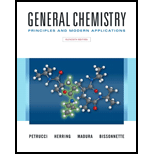
(a)
Interpretation:
The acidic anhydride of H2SO4 should be determined.
Concept introduction -
Anhydrides implies “without water”. Acid anhydrides are compound when reacts with water forms respective acid.
Acid anhydride + water → Acid
For example: CO2 is an acid anhydride when reaction with water H2O forms H2CO3.
To find the acid anhydrides from their acid, water need to be removed.
(b)
Interpretation:
The acidic anhydride of H2SO3 should be determined.
Concept introduction -
Anhydrides implies “without water”. Acid anhydrides are compound when reacts with water forms respective acid.
Acid anhydride + water → Acid
For example: CO2 is an acid anhydride when reaction with water H2O forms H2CO3.
To find the acid anhydrides from their acid, water need to be removed.
(c)
Interpretation:
The acidic anhydride of HClO4 should be determined.
Concept introduction:
Anhydrides implies “without water”. Acid anhydrides are compound when reacts with water forms respective acid.
Acid anhydride + water → Acid
For example: CO2 is an acid anhydride when reaction with water H2O forms H2CO3.
To find the acid anhydrides from their acid, water need to be removed.
(d)
Interpretation:
The acidic anhydride of HIO3 should be determined.
Concept introduction -
Anhydrides implies “without water”. Acid anhydrides are compound when reacts with water forms respective acid.
Acid anhydride + water → Acid
For example: CO2 is an acid anhydride when reaction with water H2O forms H2CO3.
To find the acid anhydrides from their acid, water need to be removed.
Want to see the full answer?
Check out a sample textbook solution
Chapter 22 Solutions
GENERAL CHEMISTRY-MOD.MASTERINGCHEM.
- help 20arrow_forwardProvide the drawing of the unknown structure that corresponds with this data.arrow_forward20.44 The Diels-Alder reaction is not limited to making six-membered rings with only car- bon atoms. Predict the products of the following reactions that produce rings with atoms other than carbon in them. OCCH OCCH H (b) CH C(CH₂)s COOCH མ་ནས་བ (c) N=C H -0.X- (e) H C=N COOCHS + CH2=CHCH₂ →→arrow_forward
- 3) Draw a detailed mechanism and predict the product of the reaction shown? 1) EtMgBr 2) H3O+arrow_forwardHow to draw the mechanism for this reaction?arrow_forward> H₂C=C-CH2-CH3 B. H₂O Pt C. + H2 + H₂O H D. 16. Give the IUPAC name for each of the following: B. Cl Cl c. Cl Cl 17. Draw the line-angle formula for each of the following compounds: 1. phenol 2. 1,3-dichlorobenzene 3. 4-ethyltoluene < Previous Submit Assignment Next ▸arrow_forward
 Chemistry by OpenStax (2015-05-04)ChemistryISBN:9781938168390Author:Klaus Theopold, Richard H Langley, Paul Flowers, William R. Robinson, Mark BlaserPublisher:OpenStax
Chemistry by OpenStax (2015-05-04)ChemistryISBN:9781938168390Author:Klaus Theopold, Richard H Langley, Paul Flowers, William R. Robinson, Mark BlaserPublisher:OpenStax ChemistryChemistryISBN:9781305957404Author:Steven S. Zumdahl, Susan A. Zumdahl, Donald J. DeCostePublisher:Cengage Learning
ChemistryChemistryISBN:9781305957404Author:Steven S. Zumdahl, Susan A. Zumdahl, Donald J. DeCostePublisher:Cengage Learning
 Chemistry: An Atoms First ApproachChemistryISBN:9781305079243Author:Steven S. Zumdahl, Susan A. ZumdahlPublisher:Cengage Learning
Chemistry: An Atoms First ApproachChemistryISBN:9781305079243Author:Steven S. Zumdahl, Susan A. ZumdahlPublisher:Cengage Learning Chemistry: Principles and ReactionsChemistryISBN:9781305079373Author:William L. Masterton, Cecile N. HurleyPublisher:Cengage Learning
Chemistry: Principles and ReactionsChemistryISBN:9781305079373Author:William L. Masterton, Cecile N. HurleyPublisher:Cengage Learning General Chemistry - Standalone book (MindTap Cour...ChemistryISBN:9781305580343Author:Steven D. Gammon, Ebbing, Darrell Ebbing, Steven D., Darrell; Gammon, Darrell Ebbing; Steven D. Gammon, Darrell D.; Gammon, Ebbing; Steven D. Gammon; DarrellPublisher:Cengage Learning
General Chemistry - Standalone book (MindTap Cour...ChemistryISBN:9781305580343Author:Steven D. Gammon, Ebbing, Darrell Ebbing, Steven D., Darrell; Gammon, Darrell Ebbing; Steven D. Gammon, Darrell D.; Gammon, Ebbing; Steven D. Gammon; DarrellPublisher:Cengage Learning





